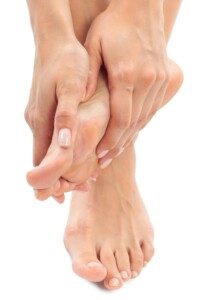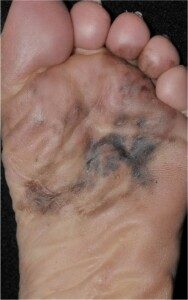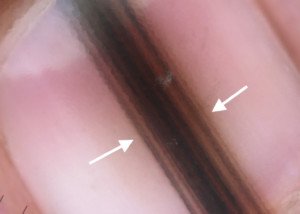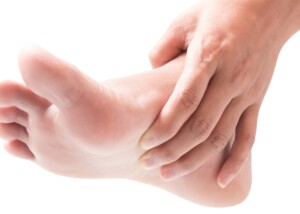
Simply glancing at your feet and toes for melanoma isn’t enough.
Here’s how to get a good look and how to spot possible signs of the deadly melanoma on your feet, toes and toenails.
“Melanoma on the toes and feet will occur either on the skin or on the nail,” says Dina D. Strachan, MD, a board certified dermatologist, and founder/director of Aglow Dermatology in Manhattan, NY.
“It may occur on the sole of the foot or the dorsal [top] skin as an irregular pigmented lesion.
“On the nails there will be brown or black discoloration under the nail that bleeds out to the surrounding skin.
“What is interesting is that melanoma is more common in people with lighter skin; however, on the toes and feet where people get acral melanoma, the rates of this type of skin cancer are the same” for both light and dark skinned people.

Acral melanoma. Xavier-Júnior, José & Munhoz, Tania & Souza, Vinicius & Campos, Eloísa & Stolf, Hamilton & Marques, Mariângela/CC BY 4.0 creativecommons.org/licenses/by/4.0, Wikimedia Commons
“People with darker skin are more likely to have benign pigmentation on the toes and feet.
“Many people with dark skin develop dark bands on their toenails and pigmented lesions on their soles that are completely benign.
“These are called melanonychia striata. These findings are more concerning in a person with lighter skin who doesn’t tan easily.
“If the whole nail becomes dark, or the discoloration appears on the surrounding skin, however, this may be a symptom of greater concern — even in a person with darker skin.”
Checking Your Toes and Feet for Melanoma
• Self-exams should be done once a month.
• Make sure your feet, toes and toenails are as clean as possible. Tiny specks of dirt can get trapped in a mole and make it look different from other moles.
• Visually inspect the entire dorsal or top area of the foot and toes, along with the nails.
• Check in between the toes.
• Look on the sides and back of the heel, and the sole of the foot.
• Use a mirror to get a good look at the underside of every toe, and right in between each toe.
• Use the mirror to also catch angles of the heel and sides of the foot that are difficult to inspect.
• You may want to prop your foot inside a sink for the inspection while standing on the other foot, if you’re flexible enough. This will enable you to securely rest your foot at a height while enabling you to lean in.
Find the close-up positioning that works best for you — and always inspect in the same room, same good lighting conditions, to make it easier to detect changes over time in a mole, or a new small spot.
• You may want to use reading glasses if you can’t get your eyes up close to a mole or spot, to increase magnification.
• Developing hip and leg flexibility makes the inspection of your feet and toes for melanoma far easier.
• If you have difficulty bending your body to get a good look at your feet, you’ll want to consider taking up yoga or a consistent stretching routine to increase your limberness.
A huge telltale sign of melanoma of a toenail is when the dark pigment “bleeds” into surrounding skin.
This is called the Hutchinson’s sign.
 Dina D. Strachan, MD, is a board certified dermatologist, consultant and speaker in New York City. She is the founder and director of Aglow Dermatology, an independent medical and cosmetic dermatology practice in Manhattan. Follow her on Instagram and LinkedIn @drdinamd.
Dina D. Strachan, MD, is a board certified dermatologist, consultant and speaker in New York City. She is the founder and director of Aglow Dermatology, an independent medical and cosmetic dermatology practice in Manhattan. Follow her on Instagram and LinkedIn @drdinamd.
 Lorra Garrick has been covering medical, fitness and cybersecurity topics for many years, having written thousands of articles for print magazines and websites, including as a ghostwriter. She’s also a former ACE-certified personal trainer.
Lorra Garrick has been covering medical, fitness and cybersecurity topics for many years, having written thousands of articles for print magazines and websites, including as a ghostwriter. She’s also a former ACE-certified personal trainer.
.


























